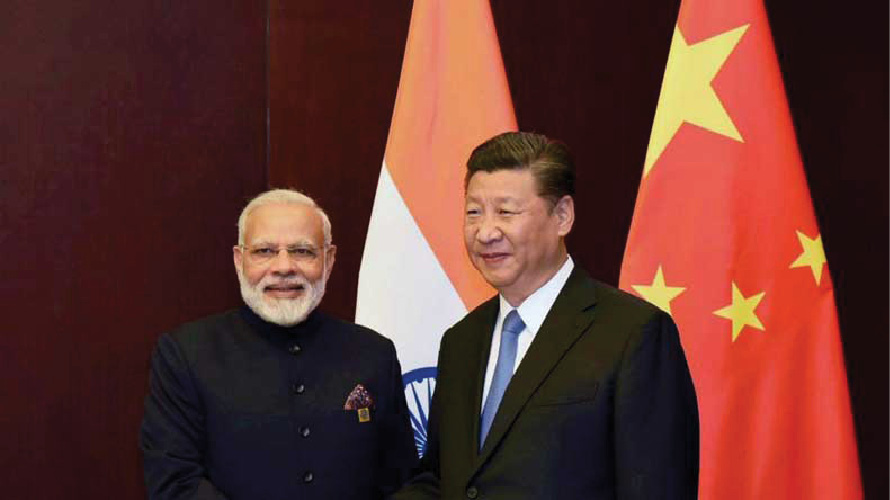It is best to keep expectations modest and realistic.
SHANGHAI: The Xi-Modi weekend retreat at Wuhan, Hubei province, has captured headlines and our collective interest. This “informal, no-agenda summit” finds precedent in China-US relations; however, it is a first for India-China relations. As early as September 2017, at the Xiamen BRICS meet, the need for an intimate space that would enable frank exchange of ideas was articulated. After months of shuttle diplomacy between New Delhi and Beijing, at progressively high levels of government, the summit (Head-of-State level meet) was set for the weekend of 27-29 April. Coincidentally, or perhaps parallely, the leaders of North and South Korea met at Panmunjom, in the De-Militarized Zone, the world’s most fortified border. The two countries are technically still at war, after cessation of hostilities in 1953, and this is the first formal meet between Presidents Moon (ROK) and Kim (DPRK).
The Korean summit was more dramatic, and emotional, since it brought together two leaders who have never set foot in each other’s territory. If indeed a permanent Korean peace agreement is signed, and the peninsula is denuclearized, then this would herald a brave new Asia and brave new world. The Wuhan Summit, on the other hand, is not intended to make history, though it does make for good optics. Modi and Xi are akin to old friends, “laopengyou”, on account of having visited each other’s hometowns, and having met in a dozen bilateral and multilateral fora. Chinese and Indian diplomatic missions are active in each other’s countries. There are regular business and people-to-people exchanges. Against the backdrop of the Doklam hostilities in 2017, bilateral trade volume touched a record 84.4 billion USD. As a long-time resident of China, I have found no vivid changes in everyday attitudes toward Indians during the ebb and flow of bilateral relations over the last decade.
It must be noted that India and China have never stopped talking, since relations were reset in December 1988, at the Rajiv Gandhi-Deng Xiaoping summit. Dialogue and cooperation mechanisms have been installed and strengthened over the decades. There is stability in this bilateral process. By the same token, the process seems to have plateaued. Negative habits of thought, and mistrust exist right alongside the dialogue mechanisms, much like parallel tracks carrying the same vehicle. In the era of President Xi and Prime Minister Modi, their personalities have certainly shaped and shifted the bilateral terrain. The leadership is right in its assessment that fresh energy and vision are urgently required to take relations out of its plateau zone, and onto greater heights.
For Wuhan (as for Panmunjom!) it is best to keep expectations modest and realistic. Modi and Xi are certainly not expected to get into the nitty-gritty of the three border sectors, or technicalities of IPR and mutual market access. Yes, these issues are vital. However, the retreat is for the leaders to assess the changing strategic environment in the Indo-Asia-Pacific, and in global trade/finance. The joint press conference held by Foreign Ministers Yi and Swaraj declared “our commonalities far outweigh our differences”. They rightly emphasised that these are two ancient civilisations tackling modern developmental goals. Civilisation is a great place to begin. However, it has contemporary relevance only if it translates to respect for each other’s needs and wants. India and China are, together, the world’s highest energy consumers. The two militaries are set on a course towards rapid modernisation; and simultaneous re-assessment of capabilities in competing spheres of influence. In fact, the PLA held its largest military parade in the South China Sea, just a few days apart from Gagan Shakti, India’s equally impressive air power exercise. The two countries cannot go very far in the Indian or Pacific Oceans, the Eurasian landmass, Middle East, or the southern continents, without reckoning with each other’s interests and installations.
If we were to genuinely spotlight commonalities and minimise differences, then Modi would point to the myriad instances of Indian cooperation, including a leading role in AIIB, contrary to Chinese narratives of Indian “obstructionism”. Indian concerns regarding CPEC have to do with sovereign territoriality, not with blocking China. India needs to ease China’s apprehensions about the Indo-Pacific Quad. By the same token, Modi would listen, and listen deeply, to Xi’s concerns regarding the Belt and Road, China’s sovereign territoriality, and anything else that might come up. India cannot, and will not, be required to take a stand on the China-US trade spat. Rather, the focus should be on leveraging our strengths in the services sector, in nudging open market-space for our manufactured and agricultural goods (not just raw material), and in enabling greater Chinese investment into India.
Most importantly, India would do well to take a page from China’s playbook in proposing a “new type of good-neighbour and Great-Power relations”. At the 2013 Xi-Obama informal summit in California, China calmly conveyed that it considers itself to be America’s equal no matter its lesser material capabilities. India, at Wuhan, can actualise an equal, fair and friendly
Indira P. Ravindran serves on the faculty of international relations at Shanghai International Studies University, PRC.

